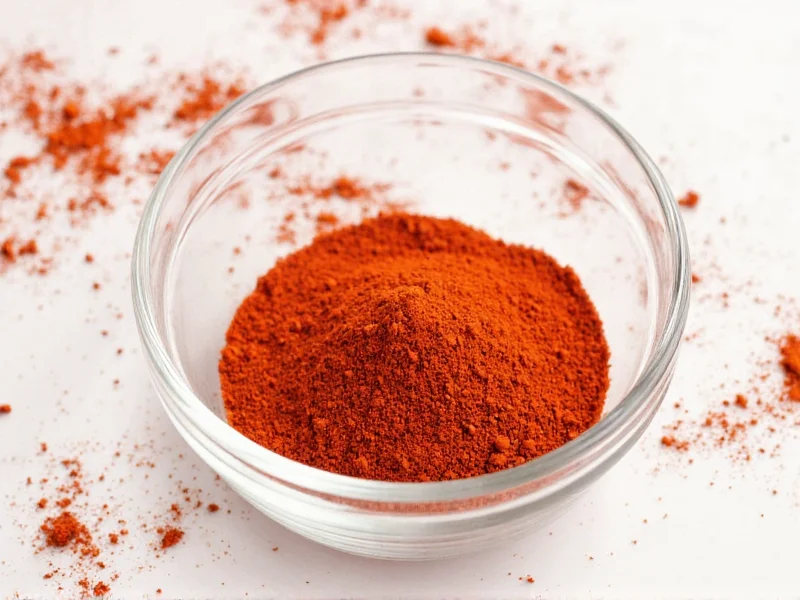The best substitutes for paprika depend on the type you need to replace. For sweet paprika, use a 1:1 ratio of tomato paste with a pinch of cayenne. For smoked paprika, combine chipotle powder with sweet paprika substitute (1/4 tsp chipotle per 1 tsp sweet substitute). For hot paprika, replace with 1/4 the amount of cayenne pepper. Always adjust to taste as these alternatives won't perfectly replicate paprika's unique flavor profile.
Running out of paprika while cooking can derail your recipe, but several effective alternatives exist. Paprika, a vibrant red spice made from ground peppers, comes in sweet, hot, and smoked varieties, each serving distinct culinary purposes. Understanding what can be substituted for paprika requires knowing which flavor profile you're trying to replicate in your dish.
Understanding Paprika Varieties Before Substituting
Paprika isn't a one-size-fits-all spice. The three main types have different flavor profiles that affect substitution choices:
- Sweet paprika - Mild, slightly sweet flavor with no heat (most common variety)
- Hot paprika - Contains cayenne or other hot peppers for noticeable heat
- Smoked paprika - Peppers are smoked before grinding, adding distinctive smoky notes
When searching for what can be substituted for paprika, the first step is identifying which variety your recipe requires. Using the wrong substitute can dramatically alter your dish's flavor balance.
Best Substitutes for Sweet Paprika
Sweet paprika provides color and mild pepper flavor without heat. When you need alternatives for sweet paprika, consider these options:
| Substitute | Ratio | Best For | Notes |
|---|---|---|---|
| Tomato paste + pinch of cayenne | 1 tbsp paste + 1/8 tsp cayenne per 1 tsp paprika | Stews, soups, sauces | Adds similar color and mild pepper flavor |
| Red bell pepper powder | 1:1 ratio | Dry rubs, spice blends | Closest flavor match but harder to find |
| Pimento powder | 1:1 ratio | Cold dishes, salads | Milder than paprika, adjust to taste |
Effective Smoked Paprika Alternatives
Replacing smoked paprika poses the biggest challenge since the smoking process creates unique compounds. When looking for what can be substituted for smoked paprika, try these combinations:
- Chipotle powder blend - Mix 1/4 tsp chipotle powder with 3/4 tsp sweet paprika substitute. Chipotle provides both heat and smoke flavor, though it's significantly hotter than smoked paprika.
- Liquid smoke solution - Add 1/8 tsp liquid smoke to your sweet paprika substitute. Use sparingly as liquid smoke can easily overpower a dish.
- Smoked salt combination - Replace 1/2 tsp of your recipe's salt with smoked salt and use sweet paprika substitute for the remaining paprika requirement.
For authentic Spanish dishes like paella where smoked paprika is essential, these alternatives won't perfectly replicate the traditional flavor but will provide acceptable results when paprika isn't available.
Substituting for Hot Paprika
Hot paprika contains additional spicy peppers. When you need to replace hot paprika, remember that direct heat substitutes require careful measurement:
- Cayenne pepper - Use 1/4 the amount of cayenne as the recipe calls for hot paprika (e.g., 1/4 tsp cayenne for 1 tsp hot paprika)
- Crushed red pepper flakes - Substitute 1/2 the amount, but note this adds texture to dishes
- Hot sauce - For liquid dishes, add 1/2 tsp hot sauce per 1 tsp hot paprika needed
When using these hot paprika alternatives, always add gradually and taste as you go. Unlike paprika, these substitutes provide immediate heat without the underlying sweet pepper flavor.
Recipe Adjustments When Substituting Paprika
Knowing what can be substituted for paprika is only half the solution. Proper implementation requires these adjustments:
- For dry rubs - If using tomato paste as substitute, reduce other liquid ingredients slightly
- For soups and stews - Add substitutes early to allow flavors to meld
- For spice blends - Increase garlic powder or onion powder slightly to compensate for flavor differences
- For color - If appearance matters, consider adding a pinch of beet powder for vibrant red color
When substituting paprika in Hungarian goulash or other paprika-dependent dishes, understand that the substitute will change the authentic flavor profile. These alternatives work best in emergencies rather than for traditional preparations.
What Not to Use as Paprika Substitutes
Certain common suggestions for what can be substituted for paprika actually create poor results:
- Paprika and cayenne mix - If you're out of paprika entirely, this isn't helpful
- Curry powder - Contains many additional spices that will alter your dish's flavor profile
- Chili powder alone - Most chili powders contain cumin and garlic which change the flavor balance
- Plain red food coloring - Adds color but no flavor dimension
Understanding these ineffective paprika alternatives prevents disappointing results when you need a quick substitute.
Storing Paprika and Alternatives Properly
Prevent future paprika emergencies by storing your spices correctly. Paprika loses potency within 6 months when exposed to light and air. Keep it in an airtight container in a cool, dark place. The same storage principles apply to paprika substitutes like chipotle powder and cayenne pepper.
For long-term storage, consider freezing paprika in a sealed container, which extends its shelf life to 1-2 years. This prevents the common situation where you think you have paprika only to discover it's lost all flavor when you need it for your recipe.











 浙公网安备
33010002000092号
浙公网安备
33010002000092号 浙B2-20120091-4
浙B2-20120091-4